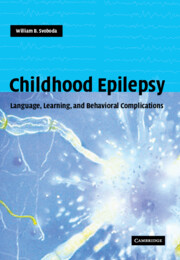Book contents
- Frontmatter
- Contents
- Preface
- Glossary
- 1 Looking ahead
- Part I Speech and language problems
- Part II Learning problems
- 12 Learning challenges
- 13 The development of learning
- 14 Learning difficulties
- 15 Learning problems with seizure types
- 16 Modifying factors
- 17 Transient cognitive impairments of epilepsy
- 18 Attention and alertness
- 19 Memory
- 20 Executive functioning
- 21 Academics
- 22 Antiepileptic medication effects
- 23 Effects of other therapies
- 24 Diagnosis
- 25 Gaining help
- 26 Frustrations of learning problems
- Part III Behavior problems
- Index
- References
21 - Academics
from Part II - Learning problems
Published online by Cambridge University Press: 26 October 2009
- Frontmatter
- Contents
- Preface
- Glossary
- 1 Looking ahead
- Part I Speech and language problems
- Part II Learning problems
- 12 Learning challenges
- 13 The development of learning
- 14 Learning difficulties
- 15 Learning problems with seizure types
- 16 Modifying factors
- 17 Transient cognitive impairments of epilepsy
- 18 Attention and alertness
- 19 Memory
- 20 Executive functioning
- 21 Academics
- 22 Antiepileptic medication effects
- 23 Effects of other therapies
- 24 Diagnosis
- 25 Gaining help
- 26 Frustrations of learning problems
- Part III Behavior problems
- Index
- References
Summary
Learning difficulties occur in up to 50% of children with epilepsy (Rutter et al., 1970; Stores, 1978; Stores, 1987; Thompson, 1987; Aldenkamp et al., 1990). This leads to the children falling behind in school subjects, dropping school grades, and eventually an increased number of students leaving school early, unprepared for earning a living.
Learning problems
Academic problems arise from specific cognitive deficiencies rather than any generalized cognitive dysfunction. Such problems include reduced attention span (Fairweather & Hutt, 1969; Rugland, 1990a), impaired memory (Stores, 1973; Stores, 1981; Stores & Hart, 1976), poor abstract reasoning (Knight & Tymchuck, 1968), perceptual difficulties, and slowed inefficient processing (Fairweather & Hutt, 1969; Waxman & Geschwind, 1975; Brittain, 1980; Kupke & Lewis, 1985; Dodrill, 1987; Aldenkamp, 1987; Beaumont, 1987; Oxley & Stores, 1987; Aldenkamp et al., 1990). These are manifest as difficulties in reading, writing, arithmetic, and other academic activities. Such problems tend to persist, especially if not remediated. Family variables such as parental income, educational levels, and psychosocial stressors do not account for the problems (Bailet & Turk, 2000).
Subgroups
There may be subgroups of children with learning disabilities identified in epileptic children, each of which display deficient reading skills and require a different form of treatment (Strang & Rourke, 1985; Aldenkamp et al., 1990).
Some children with a temporal lobe dysfunction display a memory deficiency type with problems in short-term memory and memory span, leading to disorders in the stabilization and consolidation of the word image (Strang & Rourke, 1985; Aldenkamp et al., 1990).
- Type
- Chapter
- Information
- Childhood EpilepsyLanguage, Learning and Behavioural Complications, pp. 320 - 336Publisher: Cambridge University PressPrint publication year: 2004



